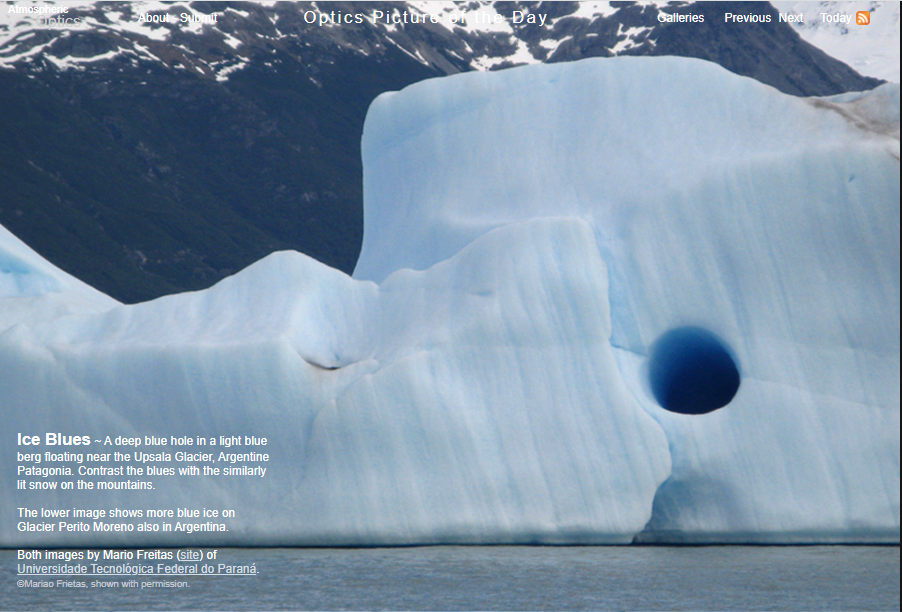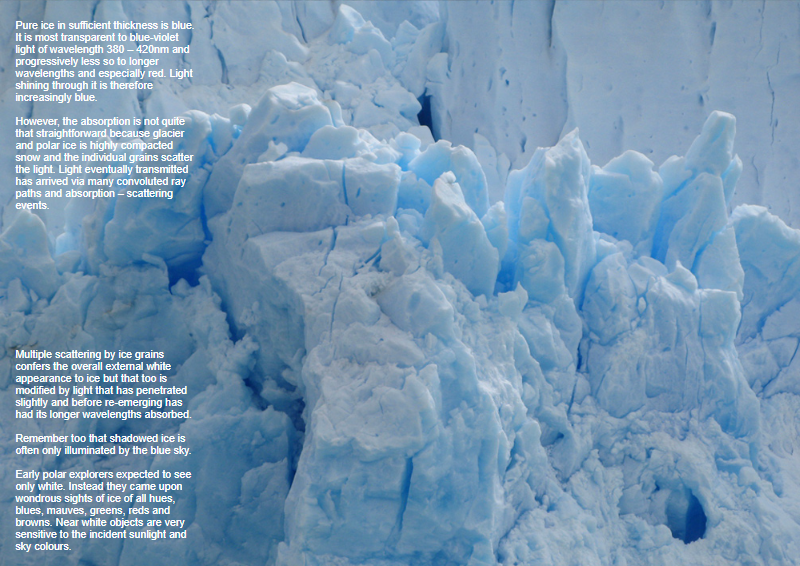Ice Blues
Ice Blues: The Fascinating Phenomenon of Blue Ice
Ice is commonly associated with a pristine white color, but there is more to ice than meets the eye. In fact, pure ice in sufficient thickness can exhibit a stunning deep blue hue. This phenomenon, known as "blue ice," occurs due to the unique optical properties of ice and the way it interacts with light. Let's dive deeper into the world of ice blues and uncover the science behind this captivating natural phenomenon.
The Science Behind Blue Ice
-
Transparency to Blue-Violet Light: Pure ice is most transparent to blue-violet light with a wavelength range of 380 – 420nm. As light passes through ice, it is progressively absorbed by longer wavelengths, especially red light. Consequently, the transmitted light appears increasingly blue.
-
Compacted Snow and Light Scattering: Glacier and polar ice are formed from highly compacted snow, consisting of individual grains that scatter light. When light passes through these ice grains, it follows convoluted ray paths and undergoes numerous absorption-scattering events. This multiple scattering gives ice its overall white appearance, but the light that penetrates slightly and re-emerges has its longer wavelengths absorbed, resulting in a modification of the white color.
-
Illumination by the Blue Sky: Shadowed ice often receives illumination solely from the blue sky. This interplay between shadow and blue sky contributes to the vibrant blues observed in ice formations.
Unveiling the Colors of Ice
-
Intrinsic Colors: While some ice colors arise from absorption, others stem from trapped micro-organisms and mineral grains within the ice. Even embedded soot from human combustion processes can modify the optical properties of polar ice. The absorption spectrum for pure ice reveals the range of colors it can exhibit, although natural ices usually have much lower transmittivity.
-
Birefringence and Thin Film Interference: Ice can also display colors due to birefringence, a property that causes light to split into two rays with different polarizations. This phenomenon can produce vibrant hues when combined with thin film interference, where light waves reflect and interfere with each other. Together, these optical effects add to the visual complexity and variety of colors seen in ice formations.
The Surprising Discoveries of Early Polar Explorers
- Unexpected Hues: Early polar explorers anticipated encountering only white ice during their expeditions. To their astonishment, they were greeted by a breathtaking array of colors, including blues, mauves, greens, reds, and browns. These colors arise from the interplay between incident sunlight, sky colors, and the sensitivity of near-white objects to light.
Appreciating the Beauty of Ice Blues
The world of ice blues is a captivating realm that offers a glimpse into the intricate and enchanting nature of our planet's ice formations. From the transparent blue-violet hues of pure ice to the vibrant colors resulting from absorption, trapped micro-organisms, mineral grains, and even human-induced soot, there is much more to ice than its traditional white appearance.
By understanding the optical properties of ice and the various phenomena that contribute to its coloration, we can better appreciate the beauty that lies within these frozen wonders. So, the next time you encounter a mesmerizing blue ice formation, take a moment to marvel at the fascinating science behind its captivating hue.

Ice Blues ~ A deep blue hole in a light blue berg floating near the Upsala Glacier, Argentine Patagonia. Contrast the blues with the similarly lit snow on the mountains.
The lower image shows more blue ice on Glacier Perito Moreno also in Argentina.
Both images by Mario Freitas (site) of Universidade Tecnológica Federal do Paraná. ©Mariao Frietas, shown with permission.

Pure ice in sufficient thickness is blue. It is most transparent to blue-violet light of wavelength 380 – 420nm and progressively less so to longer wavelengths and especially red. Light shining through it is therefore increasingly blue.
However, the absorption is not quite that straightforward because glacier and polar ice is highly compacted snow and the individual grains scatter the light. Light eventually transmitted has arrived via many convoluted ray paths and absorption – scattering events.
Multiple scattering by ice grains confers the overall external white appearance to ice but that too is modified by light that has penetrated slightly and before re-emerging has had its longer wavelengths absorbed.
Remember too that shadowed ice is often only illuminated by the blue sky.
Early polar explorers expected to see only white. Instead they came upon wondrous sights of ice of all hues, blues, mauves, greens, reds and browns. Near white objects are very sensitive to the incident sunlight and sky colours.

But many ice colours are intrinsic. The blues mostly come from absorption, other colours from trapped micro-organisms and mineral grains. Even embedded soot from our combustion processes modifies the optical properties of polar ice. The absorption spectrum at right is derived for pure ice and the transmittivity of natural ices is usually much lower.
Add to all that the colours from birefringence and thin film interference and there is much to ice for us to see.
Note: this article has been automatically converted from the old site and may not appear as intended. You can find the original article here.
Reference Atmospheric Optics
If you use any of the definitions, information, or data presented on Atmospheric Optics, please copy the link or reference below to properly credit us as the reference source. Thank you!
-
<a href="https://atoptics.co.uk/blog/ice-blues/">Ice Blues</a>
-
"Ice Blues". Atmospheric Optics. Accessed on November 26, 2024. https://atoptics.co.uk/blog/ice-blues/.
-
"Ice Blues". Atmospheric Optics, https://atoptics.co.uk/blog/ice-blues/. Accessed 26 November, 2024
-
Ice Blues. Atmospheric Optics. Retrieved from https://atoptics.co.uk/blog/ice-blues/.